Women in Prison Films of the 70s and 80s:
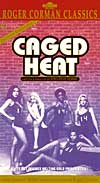 And
director Jonathan Demme's first feature Caged Heat (1974), made for
Roger Corman's New World Pictures, was a low-budget, B-grade campy sexploitation
classic - with empowered tough women, designed for the drive-in crowd. It
is now considered one of the best of its type - an "innocent females
in prison" film, advertised as "White Hot Desires Melting Cold Prison
Steel!," with frequent shower sequences showing off a nude "Rainbeaux"
Smith and Erica Gavin. The Exorcist's Linda Blair and Sybil Danning
were others who appeared in women-behind-bars (or in reform schools) trash
films, with healthy amounts of gratuitous nudity, as in the made-for-TV Born
Innocent (1974), Chained Heat (1983), and Reform School Girls
(1986). And
director Jonathan Demme's first feature Caged Heat (1974), made for
Roger Corman's New World Pictures, was a low-budget, B-grade campy sexploitation
classic - with empowered tough women, designed for the drive-in crowd. It
is now considered one of the best of its type - an "innocent females
in prison" film, advertised as "White Hot Desires Melting Cold Prison
Steel!," with frequent shower sequences showing off a nude "Rainbeaux"
Smith and Erica Gavin. The Exorcist's Linda Blair and Sybil Danning
were others who appeared in women-behind-bars (or in reform schools) trash
films, with healthy amounts of gratuitous nudity, as in the made-for-TV Born
Innocent (1974), Chained Heat (1983), and Reform School Girls
(1986).
More Adult-Oriented Films in the Late 60s and 70s:
Adult-themed, prestigious, sexually-mature and powerful films
in the late 1960s and early 1970s also caused a stir, and were among the earliest
films given a new X rating by the MPAA Rating Code. The only Best Picture
(and Best Director) winner that was rated X (later changed to R) was John
Schlesinger's  Midnight Cowboy (1969). It was about the seedy life and camaraderie
of two desperate souls (one a would-be gigolo street hustler portrayed by
Jon Voight) in a seedy section of New York City. Midnight Cowboy (1969). It was about the seedy life and camaraderie
of two desperate souls (one a would-be gigolo street hustler portrayed by
Jon Voight) in a seedy section of New York City.
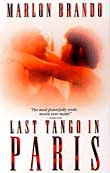 Bernardo
Bertolucci's landmark, controversial erotic film about a destructive relationship, Last Tango in Paris (1972), an Italian-French co-production financed
by United Artists, featured an aging, grieving widower and American expatriate
Paul (Marlon Brando) and a much younger 20 year-old Parisienne ingenue Jeanne
(Maria Schneider) who relieved emotional pain through anonymous but passionate
sex. The film received an X-rating for its explicit and uninhibited sex scenes,
and was nominated for Best Director and Best Actor Oscars. In 1974, it became
the first film to be prosecuted under Britain's Obscene Publications
Act. Bernardo
Bertolucci's landmark, controversial erotic film about a destructive relationship, Last Tango in Paris (1972), an Italian-French co-production financed
by United Artists, featured an aging, grieving widower and American expatriate
Paul (Marlon Brando) and a much younger 20 year-old Parisienne ingenue Jeanne
(Maria Schneider) who relieved emotional pain through anonymous but passionate
sex. The film received an X-rating for its explicit and uninhibited sex scenes,
and was nominated for Best Director and Best Actor Oscars. In 1974, it became
the first film to be prosecuted under Britain's Obscene Publications
Act.
Stanley Kubrick's X-rated masterpiece A
Clockwork Orange (1971) was a dark satire regarding violence, sex
(previously unseen on the big screen), rape, and the freedom-denying effects
of aversion therapy. Kubrick was personally responsible
for withdrawing the film from distribution in the UK (for almost 30 years)
when it was linked to copy-cat crimes by youth gangs. David Lean's Ryan's
Daughter (1970) brought conflict over its rating due to Sarah Miles' nude
scene with Christopher Jones. Nicolas Roeg's debut film Walkabout (1971) was also questioned regarding Jenny Agutter's nude swimming scenes in the
Australian outback.
And during the horrors of war in Korea in a surgical hospital
in Robert Altman's irreverent film M*A*S*H (1970), the surgeons played
practical jokes, including the broadcast of a Sally Kellerman's hot request
of Robert Duvall: "Oh Frank, my lips are hot...Kiss my hot lips."
Peter Bogdanovich's The Last Picture
Show (1971), a slice of life R-rated film about life and loss of innocence
in a small Texas town, provided brief glimpses of a nude, young Cybill Shepherd
skinny-dipping at an indoor pool party with other naked teens (in full-frontal
views), and then experiencing a failed, awkward deflowering with Jeff Bridges
in a motel room (but she tells her girlfriend-classmates "I just can't describe
it in words"). Other controversial scenes included a high school student's
(Timothy Bottoms) affair with his school coach's wife (Cloris Leachman), and
the deflowering of the town's mentally-retarded boy with a prostitute.
Director Mike Nichols' Carnal Knowledge (1971) (mixed
with Jules Feiffer's cynical script) surveyed three decades (late 1940s-60s)
in the contrasting sex lives of two college roommates: studly, chauvinistic
Jack Nicholson (and eventual wife Ann-Margret) and shy, bumbling Art Garfunkel.
The film was argued as being obscene for its explicit dialogue, borderline
nudity, and suggestive final scene of oral sex.
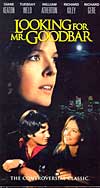 In
Sam Peckinpah's Straw Dogs (1971), after slutty Amy (Susan George),
the young wife of mild-mannered mathematician Dustin Hoffman, was raped by
her ex-boyfriend (Del Henney) - and seemed to enjoy it (lending to the film's
controversy), she was also sexually brutalized by one of the ruffian's friends.
Sadistic revenge and violence erupted as a result - It was one of the most
controversial rape sequences ever filmed, and the alarming film was accused
of glorifying and inspiring men to assault women with sexual violence. Homosexual
rape was portrayed in an infamous and shocking scene in director John Boorman's Deliverance (1972). Bobby, aka Chubby (Ned
Beatty) was sodomized by a Mountain Man, who first makes him squeal like a
pig ("Wheeeee! . . . Wheeeee! . . . Wheeeee!"). In
Sam Peckinpah's Straw Dogs (1971), after slutty Amy (Susan George),
the young wife of mild-mannered mathematician Dustin Hoffman, was raped by
her ex-boyfriend (Del Henney) - and seemed to enjoy it (lending to the film's
controversy), she was also sexually brutalized by one of the ruffian's friends.
Sadistic revenge and violence erupted as a result - It was one of the most
controversial rape sequences ever filmed, and the alarming film was accused
of glorifying and inspiring men to assault women with sexual violence. Homosexual
rape was portrayed in an infamous and shocking scene in director John Boorman's Deliverance (1972). Bobby, aka Chubby (Ned
Beatty) was sodomized by a Mountain Man, who first makes him squeal like a
pig ("Wheeeee! . . . Wheeeee! . . . Wheeeee!").
Michael York played the part of a bisexual in Bob Fosse's
musical Cabaret (1972), and Al Pacino robbed a bank in Sidney Lumet's Dog Day Afternoon (1975) in order to finance his homosexual lover's
sex-change operation. Looking for Mr. Goodbar (1977), a sexually frank
adaptation of Judith Rossner's best-seller, descended into the carnal depths
of New York singles bars during the sexual revolution, and ended with the
predictable, chilling fate of one promiscuous Catholic school teacher and
female cruiser (Diane Keaton, an Oscar-winner in the same year for Annie
Hall) searching for the perfect one-night-stand.
The scandalous, ostracized, imported Japanese film In
the Realm of the Senses (1976) explored the sensually explicit,
erotic world of two lovers - re-made in the US as The Sailor
Who Fell From Grace With The Sea (1976) with graphic scenes
between Kris Kristofferson and Sarah Miles. Writer/director
Paul Schrader's film Hardcore (1979) told about the one-man
crusade of conservative businessman and religious Michigan Calvinist
Jake Van Dorn (George C. Scott), a single parent. His obsessed objective
was to find his misguided daughter Kristen (Ilah Davis), who had
run away from Grand Rapids, Michigan to California to join the world
of the underground porn film industry. The ending's reunion was
predictable, but heart-breaking and revealing, when the desperate
Jake, after searching in Los Angeles and San Diego, finally located
Kristen in San Francisco. Van Dorn let Kristen decide whether to
come home or not (although he begged her to return). At first, she
rejected him in anger for not loving her, but then relented and
changed her mind.
Sex in Mainstream Hollywood Films Overwhelms Soft-Core
Sexploitation Pictures:
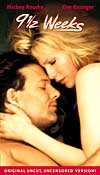  MTV-style
director Adrian Lyne's glossy 9 1/2 Weeks (1986), with a screenplay
by soft-core erotica veteran Zalman King, was released in a more explicit,
unrated video version than the R-rated theatrical release. It displayed generous
samplings of kinky and raunchy sex, and the endlessly creative, obsessive
and experimental ways two erotic adventurers/lovers Mickey Rourke and Kim
Basinger aroused themselves during a two-month affair. The film contained
one of the best erotic food seductions ever filmed, involving blindfolds,
ice cubes, chocolate syrup, and other ingredients. MTV-style
director Adrian Lyne's glossy 9 1/2 Weeks (1986), with a screenplay
by soft-core erotica veteran Zalman King, was released in a more explicit,
unrated video version than the R-rated theatrical release. It displayed generous
samplings of kinky and raunchy sex, and the endlessly creative, obsessive
and experimental ways two erotic adventurers/lovers Mickey Rourke and Kim
Basinger aroused themselves during a two-month affair. The film contained
one of the best erotic food seductions ever filmed, involving blindfolds,
ice cubes, chocolate syrup, and other ingredients.
[Zalman King would go on to direct three equally erotic,
soft-porn films with strong sexual content: Two Moon Junction (1988) with
Sherilyn Fenn, Wild Orchid (1989) - again with 9 1/2 Weeks'
Mickey Rourke and Carre Otis (in her film debut) and featuring a very
believable/simulated sex scene, and the made-for-TV Red
Shoe Diaries (1992) with X-Files TV star David Duchovny.]
The face of Hollywood lesbianism was tamely reflected in the glossed-over,
scaled-down stories of The Color Purple (1985) and Fried Green
Tomatoes (1991).
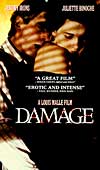 Outside
of the Hollywood system, Steven Soderbergh's independent film sex, lies
and videotape (1989) followed the videotaping of the complex sex lives
of the protagonists with sexually-suggestive and provocative content, but
without overt scenes of sex or nudity. Foreign films
with frank sexual content were usually re-shot or released with modified content
in the US, e.g., Louis Malle's intimate exploration of obsessive and damaging
passion in Damage (1992) with Jeremy Irons and Juliette Binoche, or
Jean-Jacques Annaud's The Lover (1992). Other erotic foreign films
included Betty Blue (1986. Fr.) with the ripe and beautiful Beatrice Dalle
destroyed by amour fou, and French director Jacques Rivette's very-lengthy (almost four hour) drama La Belle Noiseuse (1991, Fr.) with Emmanuelle
Beart as an newly-inspired painter's starkly nude model for the majority of the film. Outside
of the Hollywood system, Steven Soderbergh's independent film sex, lies
and videotape (1989) followed the videotaping of the complex sex lives
of the protagonists with sexually-suggestive and provocative content, but
without overt scenes of sex or nudity. Foreign films
with frank sexual content were usually re-shot or released with modified content
in the US, e.g., Louis Malle's intimate exploration of obsessive and damaging
passion in Damage (1992) with Jeremy Irons and Juliette Binoche, or
Jean-Jacques Annaud's The Lover (1992). Other erotic foreign films
included Betty Blue (1986. Fr.) with the ripe and beautiful Beatrice Dalle
destroyed by amour fou, and French director Jacques Rivette's very-lengthy (almost four hour) drama La Belle Noiseuse (1991, Fr.) with Emmanuelle
Beart as an newly-inspired painter's starkly nude model for the majority of the film.
The NC-17 Rating:
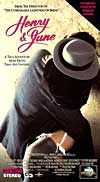 Non-pornographic
depictions of serious adult themes and lesbian sex led the MPAA to give up
the X rating and create the NC-17 category. The first film to receive
the MPAA's new NC-17 rating was director Philip Kaufman's Henry & June
(1990), about the erotic lives in a lover's triangle in 1930s Bohemian
Paris between writer Anais Nin (Maria DeMedeiros), American Henry Miller (Fred
Ward), and his wife June (Uma Thurman). It was advertised as "a true
adventure more erotic than any fantasy." [Kaufman's equally erotic previous
film was The Unbearable Lightness of Being (1988) with open adult sexuality
displayed by Daniel Day-Lewis, Juliette Binoche, and Lena Olin.] Non-pornographic
depictions of serious adult themes and lesbian sex led the MPAA to give up
the X rating and create the NC-17 category. The first film to receive
the MPAA's new NC-17 rating was director Philip Kaufman's Henry & June
(1990), about the erotic lives in a lover's triangle in 1930s Bohemian
Paris between writer Anais Nin (Maria DeMedeiros), American Henry Miller (Fred
Ward), and his wife June (Uma Thurman). It was advertised as "a true
adventure more erotic than any fantasy." [Kaufman's equally erotic previous
film was The Unbearable Lightness of Being (1988) with open adult sexuality
displayed by Daniel Day-Lewis, Juliette Binoche, and Lena Olin.]
The NC-17 rating was originally designed to distinguish films
with serious sexual content from regular, X-rated pornographic fare. Its rating
restricted anyone under the age of 17 from attending a film. Nowadays, an
NC-17 rating is the box-office kiss of death because many movie theatres won't
book films with that rating, and major national video chains (e.g., Blockbuster)
refuse to carry NC-17 or X-rated movies. So most major studios avoid having
films released with more than an R rating, by cutting footage that would produce
a NC-17 rating. Now, the NC-17 rating dictates film content and acts as a
voluntary system of censorship within Hollywood.
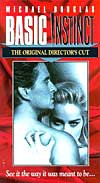 Oftentimes
after 1990, filmmakers would make token cuts of a few minutes (or seconds)
of footage of objectionable sex scenes in their films to obtain an R rating
for their opening theatrical release, and then add the footage back into videotape-released,
'unrated' versions (or special 'director's cuts'). The buzz generated from
headlines about the sexual content of a film actually benefited many pictures
and was sought after as free publicity. Oftentimes
after 1990, filmmakers would make token cuts of a few minutes (or seconds)
of footage of objectionable sex scenes in their films to obtain an R rating
for their opening theatrical release, and then add the footage back into videotape-released,
'unrated' versions (or special 'director's cuts'). The buzz generated from
headlines about the sexual content of a film actually benefited many pictures
and was sought after as free publicity.
The next permissive film to cause headlines over its steamy
content, depiction of lesbian characters, violent ice-pick murders, "date
rape" scene with Jeanne Tripplehorn, sexy interrogation scene with panty-less
Sharon Stone crossing her legs, and a threatened NC-17 rating was director
Paul Verhoeven's sex thriller Basic Instinct (1992).
The rating would cost the expensive film about 50-75% of its potential bookings.
So the film was cut to receive an R rating for its theatrical release, although
it was also released with a more explicit 'Director's Cut' version for the
video market.
The Video Revolution in the 80s:
The advent of home video (the proliferation of cable TV, consumer
camcorders, and VCRs) in the early 80s had a tremendous impact on the production
and proliferation of X-rated films, and on the entire film industry. Now films
could be made more cheaply, and there was a trend toward increasing independent
production. Consumers could view the increased number of products in the privacy
of their own homes rather than in theatres. And much more explicit films could
be manufactured.
Memorable Sexual Films and Scenes:
Most films in modern cinema, especially with mainstream actors
and actresses, were not full-blown, sex-titillating works designed to contain
wall-to-wall eroticism. Many contained only a few sequences or dissected moments
of sexuality (sometimes gratuitously added), that weren't necessarily seamlessly
integrated into the plot.
These are some examples of sexy/erotic moments in films from
the late 50s through the 70s:
 Sophia Loren as Phaedra, an earthy Greek sponge diver
in a skin-tight, tucked-in dress in Boy on a Dolphin (1957) Sophia Loren as Phaedra, an earthy Greek sponge diver
in a skin-tight, tucked-in dress in Boy on a Dolphin (1957)- the much-imitated, extended bawdy, food-related sex scene,
with meat and fruit providing the aphrodisiac in the lusty Tom Jones
(1963)
- the
many sexy beauties in the James Bond films including Ursula Andress, Honor
Blackman, Jane Seymour, Maud Adams, Britt Ekland, Carole Bouquet, Diana
Rigg, Tanya Roberts, Maryam D'Abo, Talisa Soto, Sophie Marceau and many
more
- the chilly British film Alfie (1966), with Michael
Caine's first starring role as a charming but contemptuous playboyish rogue
and lothario - with an early, candid view of sexual promiscuity, abortion,
and pregnancy - [the film was remade by director Charles Shyer as Alfie
(2004) - the story was transplanted to New York City with Jude Law in
the title role as a desirable limo driver]
- the unlikely sights of Raquel Welch as a cavewoman in a
two-piece furry bikini in One Million Years B.C. (1966) and leopard-skin,
bikini-clad prehistoric women in When Dinosaurs Ruled the Earth (1970)
- the sensual, but bored housewife Catherine Deneuve and
her bordello fantasies in Bunuel's Belle De Jour (1967)
- the languid honeymoon nude scene between young actors
Leonard Whiting and Olivia Hussey in Romeo and Juliet
(1968) with her split-second toplessness as she rolls out of their
bed at dawn
- the doomed, steamy affair and bathtub washing scene (and
the notorious butter scene!) between Marlon Brando and French girl Maria
Schneider in Bernardo Bertolucci's groundbreaking Last Tango in Paris
(1972) - about a man's struggle to forget his wife's death
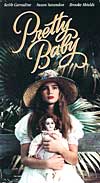 the
notorious, convincing love-making scene between Donald Sutherland and Julie
Christie in Don't Look Now (1973) the
notorious, convincing love-making scene between Donald Sutherland and Julie
Christie in Don't Look Now (1973)- Radley Metzger's X-rated Naked Came the Stranger (1975)
- the bondage/S & M scenes in The Story of O (1975)
- the classic love-making scene between paraplegic Jon Voight
and Jane Fonda in Coming Home (1978)
- child actress Brooke Shields as Violet - a pre-teenage
virginal child about to be auctioned off and deflowered on her 12th birthday,
and her prostitute mother Susan Sarandon wiping away white powder from her
breast with a wet finger during a photography portrait session in a turn-of-the-century
New Orleans bordello in Louis Malle's semi-scandalous Pretty Baby (1978)
- the perfect '10' Bo Derek with corn-rows in her hair as
a fantasy dream woman running in slow-motion in the voyeuristic beach scene
(for Dudley Moore), and the notorious bedroom scene with love-making accompanied
by repeated playings of Ravel's Bolero (after Derek's question: "Did
you ever do it to Ravel's Bolero?") in 10 (1979)
|

![]() Sexual-Erotic Films
Sexual-Erotic Films ![]()